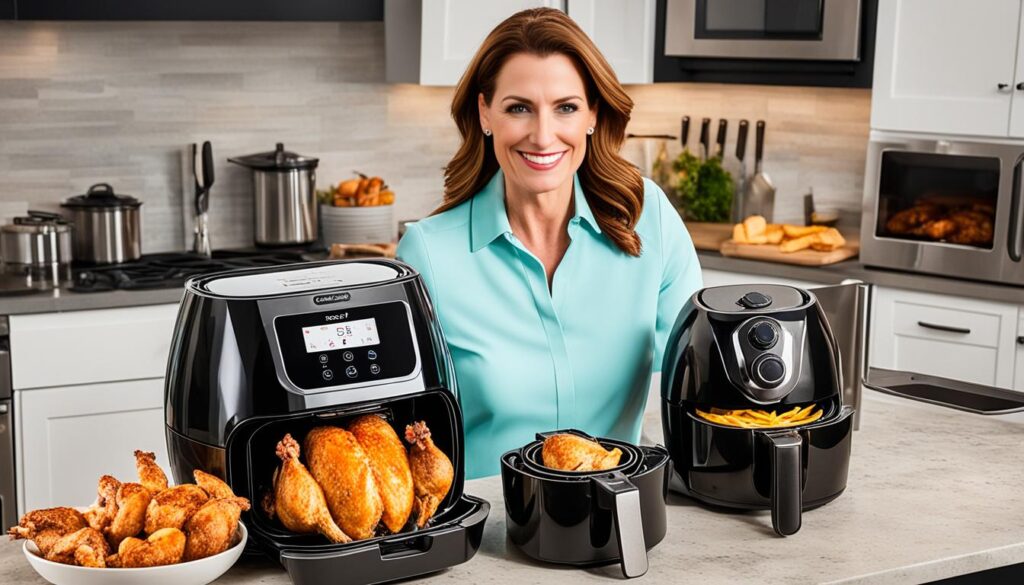When it comes to cooking appliances, air fryers and convection ovens have become popular choices for those looking for healthier cooking options. But have you ever wondered what sets these two appliances apart? Are they really just different names for the same thing? Let’s dig deeper and uncover the key differences between air fryers and convection ovens.
While both air fryers and convection ovens utilize fans to circulate heat, their functionalities and features differ in significant ways. Understanding these differences can help you make an informed decision when choosing the right appliance for your cooking needs.
In this article, we will compare air fryers and convection ovens in terms of preheating time, cooking time, capacity, and heating elements. By the end, you’ll have a clearer understanding of which appliance suits your cooking preferences best.
So, are air fryers really the same as convection ovens? Let’s find out!
Is an Air Fryer a Convection Oven?
While considering air fryers versus convection ovens, it’s important to understand that they are not the same appliance. Although they share similarities in their cooking methods, there are distinct differences that set them apart.
Air fryers are typically smaller in size compared to convection ovens. They are designed to cook food using rapid air circulation, which results in crispy and delicious dishes with minimal oil. Air fryers often have a top-down cooking mechanism and may not include a bottom heating element. This unique design allows for efficient and quick cooking, which is perfect for smaller households or individuals looking for a compact appliance.
On the other hand, convection ovens utilize a combination of a main heating element, a fan, and sometimes a third heating element (in True Convection models). This arrangement distributes heat evenly throughout the oven cavity, providing consistent and reliable cooking results. Some convection ovens even come with dedicated air fry settings, allowing users to bake, roast, and air fry all in one versatile appliance. This offers convenience and flexibility for those who require more cooking space or prefer the convenience of a multi-purpose oven.
In conclusion, while air fryers and convection ovens operate on similar principles, they have distinct differences that cater to different cooking needs and preferences. Consider the size, heating methods, and cooking capacities when deciding between an air fryer and a convection oven.
Differences Between Air Fryers and Convection Ovens
While both air fryers and convection ovens use fans to circulate air, they have key differences that can affect the end results of recipes. Understanding these differences can help you make an informed decision when choosing between an air fryer and a convection oven.
Air Fryer Benefits:
- Creates a crunchy, crisp exterior similar to traditional fried foods
- Ideal for cooking small portions
- Great for quick cooking and saving time
- Offers a healthier alternative to deep frying, requiring little to no oil
Convection Oven Benefits:
- Well-suited for roasting and baking
- Provides larger cooking capacity for bigger quantities
- Allows for versatile cooking options beyond air frying
- Offers more even heat distribution for consistent cooking results
These differences reflect the unique abilities and strengths of each appliance. Air fryers focus on achieving a crispy texture with minimal oil, while convection ovens provide a wider range of cooking capabilities, making them suitable for various recipes.
When it comes to choosing between an air fryer and a convection oven, consider your cooking preferences, desired cooking capacity, and the types of recipes you plan to prepare. Are you looking for a convenient solution for quick, healthier versions of fried foods? An air fryer might be the perfect fit. Do you need a versatile appliance that can handle larger quantities and offer a wider range of cooking options? A convection oven might be the better choice. It ultimately depends on your individual needs and kitchen requirements.
To help you further understand the differences between air fryers and convection ovens, take a look at the table below:
| Features | Air Fryer | Convection Oven |
|---|---|---|
| Preheating Time | Shorter preheat time due to smaller size | Longer preheat time compared to air fryers |
| Cooking Time | Efficient air circulation leads to faster cooking times | Slightly longer cooking times, but with more even heat distribution |
| Temperature | Typically cooks at lower temperatures than conventional ovens | Allows for a wide range of cooking temperatures |
| Cooking Capacity | Small capacity, ideal for individual servings or small families | Larger capacity, suitable for cooking larger quantities |
By considering the benefits and differences outlined above, you can determine whether an air fryer or a convection oven is the right choice for your cooking needs and preferences.
Preheating Time
When it comes to preheating time, air fryers have a clear advantage over convection ovens. Due to their smaller size and compact design, air fryers can reach the desired temperature much faster than convection ovens. While convection ovens typically take around 20 to 25 minutes to preheat, air fryers can have a much shorter preheat time, ranging from just 3 to 5 minutes.
This shorter preheating time can be quite convenient, especially when you’re in a hurry or craving a quick and crispy meal. With an air fryer, you can enjoy deliciously cooked food in a fraction of the time it takes to preheat a convection oven.
“The shorter preheating time of air fryers makes them a popular choice for busy individuals who value efficiency and convenience.”
If you’re looking to save time in the kitchen and enjoy quick and tasty meals, an air fryer may be the perfect appliance for you.
Air Fryer vs. Convection Oven Preheating Time Comparison:
| Appliance | Preheating Time |
|---|---|
| Air Fryer | 3-5 minutes |
| Convection Oven | 20-25 minutes |
As seen in the table above, the preheating time of air fryers is significantly shorter compared to convection ovens. This time-saving feature allows you to quickly cook your favorite meals without sacrificing taste or quality.
Now that we’ve explored the differences in preheating time, let’s move on to another important factor – cooking time.
Cooking Time
The cooking time is an important factor to consider when comparing air fryers and convection ovens. While both appliances can offer efficient cooking times, there are some differences to be aware of.
Air fryers are designed to circulate hot air quickly and evenly, resulting in faster cooking times for certain foods. This is due to their compact size and specialized cooking mechanism. The efficient circulation of hot air in an air fryer helps to cook food quickly and evenly, reducing the overall cooking time.
On the other hand, convection ovens may have slightly longer cooking times compared to air fryers. This is because convection ovens typically have a larger cooking capacity and may require more time for the heat to distribute evenly throughout the oven cavity. However, it’s important to note that the specific cooking time can vary depending on the recipe and the desired level of doneness.
In general, both air fryers and convection ovens offer relatively quick cooking times compared to traditional ovens.
| Appliance | Cooking Time |
|---|---|
| Air Fryer | Faster cooking times due to efficient circulation of hot air |
| Convection Oven | Slightly longer cooking times due to larger cooking capacity |
Table: Cooking Time Comparison between Air Fryers and Convection Ovens

Temperature
When it comes to cooking temperature, both air fryers and convection ovens generally operate at similar temperatures. Typically, these appliances use temperatures that are approximately 20 to 25 degrees lower than conventional ovens. This lower temperature range is ideal for achieving crispy and evenly cooked results in a shorter amount of time.
Convection ovens and air fryers also offer the option to cook at lower temperatures for longer periods. This can be especially useful when preparing delicate dishes or when you want to slow cook certain foods. By cooking at lower temperatures, the heat is distributed more evenly throughout the food, resulting in a more consistent and efficient cooking process.
Whether you’re using an air fryer or a convection oven, it’s important to carefully monitor the cooking temperature to ensure that your food is cooked to perfection. Many models come with built-in temperature controls and digital displays, making it easier to adjust and maintain the desired cooking temperature.
| Air Fryer | Convection Oven | |
|---|---|---|
| Lowest Temperature Setting | 200°F | 180°F |
| Highest Temperature Setting | 400°F | 450°F |
“The lower cooking temperature of air fryers and convection ovens allows for a healthier cooking method while still achieving delicious results. Whether you’re looking to make crispy fries or a perfectly roasted chicken, these appliances allow you to cook with precision and efficiency.”
Cooking Capacity
In the debate between air fryers and convection ovens, another important aspect to consider is cooking capacity. When it comes to cooking larger quantities, convection ovens outshine air fryers. Air fryers are designed to accommodate small portions, typically around two servings. If you’re cooking for a small household or prefer individual servings, an air fryer may be suitable for your needs.
However, if you have a larger family or often host gatherings, a convection oven is the better choice. These appliances offer more substantial cooking capacities, allowing you to prepare meals for multiple people without the need for multiple batches. From roasting a whole chicken to baking a large tray of cookies, a convection oven provides the space you need to cook in larger quantities.
It’s worth noting that the difference in cooking capacity between air fryers and convection ovens is not just about the physical size of the appliance. Convection ovens are designed with larger interiors and racks that can hold more food, making them the preferred option for those looking to cook larger portions.
Cooking Capacity Comparison
| Appliance | Cooking Capacity |
|---|---|
| Air Fryer | Small portions, typically around 2 servings |
| Convection Oven | Larger capacity, suitable for cooking for larger families or when hosting gatherings |
Choosing Between an Air Fryer and a Convection Oven
The decision to choose between an air fryer and a convection oven ultimately depends on your individual cooking needs and preferences. While both appliances have their advantages, determining the best option for you requires considering factors like cooking space, versatility, and desired culinary outcomes.
If you require ample cooking space and a versatile appliance that can handle a variety of cooking tasks, a convection oven might be the ideal choice. Convection ovens typically have larger capacities, making them suitable for cooking larger quantities or when catering to large families and gatherings.
On the other hand, if you prioritize enjoying crispy fried foods with less oil, and have limited kitchen space or prefer a standalone appliance, an air fryer can be a fantastic option. Air fryers offer a compact size and are specifically designed to create that sought-after crispy texture while using little to no oil.
To experience the benefits of both air frying and convection cooking, Whirlpool offers ranges that combine both functionalities. These innovative appliances provide the best of both worlds, allowing you to enjoy the convenience of air frying and the versatility of convection cooking in one appliance.
